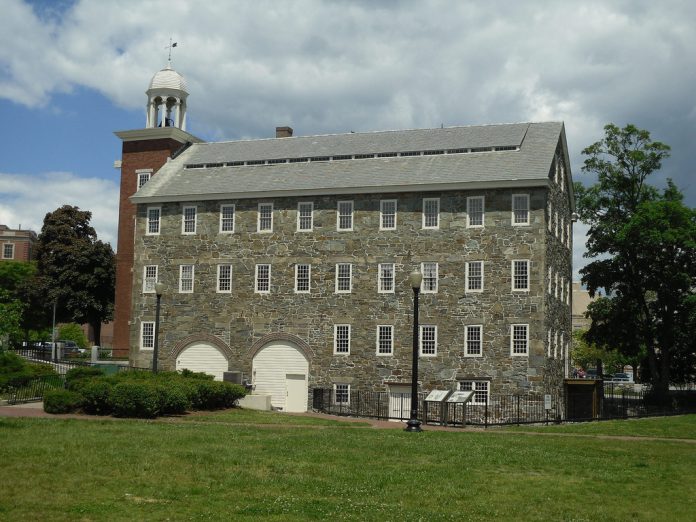
Those of you who pay attention may recall that in the Jan. 4 Let’s Talk Rusty Iron column about treadmills I made the following statement, “The first successful factory in America was Slater and Brown’s Cotton Mill that opened in Pawtucket, R.I. in 1790.
This factory, including the treadmill that powered the looms, is said to have been manned by children aged 4-10.”
Rebuttal
This brought a sharp rebuttal from Philip Way, who wrote (via email), “Sam, please! Whoever told you that fable about the Slater Mill?”
“It was entirely water powered, being located on the Blackstone River in what became known as Central Falls, Rhode Island, (and still was when I lived there in the ’80s). Never any need for treadmills.
“The whole Blackstone Valley was already a nascent industrial mecca, because its fall rate could power mills going all the way up to Worcester, Massachusetts.
“Slater copied English machinery on which he had been apprenticed, which spun cotton yarn. I never researched it, but I would expect to find a mill or two on the Blackstone doing ironworking, too. The skills and the iron to make Slater’s first spinning frames must have come from somewhere.
“Slater did hire children, but only because he hired whole families, providing them with living quarters and even a company store, copying what his master Arkwright had done in Derbyshire decades earlier.”
As I originally included that statement in a story on treadmills I did for Rural Heritage magazine more than 20 years ago, I have no recollection of where I found that information, nor can I find it again.
Samuel Slater
Samuel Slater, born in 1768, worked in an English cotton-mill as an apprentice. The mill at Belpre was run by Jedediah Strutt who was a partner of Richard Arkwright, an inventor of several early textile making machines.
Slater was young and ambitious and didn’t see a future with Strutt, so he looked to emigrate to America.
At that time, the British jealously guarded their industrial machinery and knowledge in order to maintain the lucrative markets of the colonies, and America after its independence.
Even men with technical training in these industries, such as Slater, were prohibited from emigrating, and there was no way he could take a model or plans for any machine out of the country.
Slater, however, was young, determined, and apparently had a photographic memory. Disguised as a farmer, and with the plans for machinery in his head, he made it to New York in 1789.
Slater hooked up with Moses Brown, a cotton manufacturer whose mill in Pawtucket, Rhode Island, was not able to make yarn to compete with the British imports.
Slater Mill
They formed a partnership, called Almy, Brown, and Slater, and Slater set to work, with the help of a first-rate “mechanician” named Sylvanus Brown, to construct from memory Arkwright’s textile machines.
According to one account (Machines That Built America by Roger Burlingame, published in 1953), Brown and Slater “were assisted by a 10-year-old boy and a Negro who, during the experiments before the machines were ready to hitch to the water wheel, furnished their motive power with the muscles of his arms and back.”
A Popular History of American Invention, edited by Waldemar Kaempffert and published in 1926, tells us, “Slater’s first real mill, built in 1793, had as its motive power an old negro known as “Primus” Jenks; but this colorful method of operation proved too slow, and the first water-power spinning plant in America soon succeeded the clumsy efforts of the faithful “Primus.”
The PBS series Who Made America says on its page about Samuel Slater, “With the support of a Quaker merchant, Moses Brown, Slater built America’s first water-powered cotton spinning mill in Pawtucket, Rhode Island.
By the end of 1790, it was up and running, with workers walking a treadmill to generate power. By 1791, a waterwheel drove the machinery that carded and spun cotton into thread.”
Correction
Nowhere can I find any reference to children manning the treadmill, so that statement in my original story probably isn’t true. Thanks to Mr. Way for pointing this out.
In any event, it’s apparent that by 1791 or thereabouts, Sam Slater had a successfully functioning cotton spinning mill in operation using water power.
In fact, one account claims that after three years of operation the Brown-Slater mill had to shut down due to a lack of raw cotton to spin.
The 1926 book states that in 1791 there were 489,000,000 pounds of raw cotton produced in the entire world, only 138,234 pounds of which that were grown in this country — no wonder Slater’s mill out-spun the raw cotton supply.
Eli Whitney perfected his revolutionary cotton gin at about this time, however, and cotton production in the United States soared to 35,000,000 pounds in 1800.
And at the time of the publication in 1926 of A Popular History of American Invention, more than seven billion pounds of the world’s cotton supply came from the USA.












